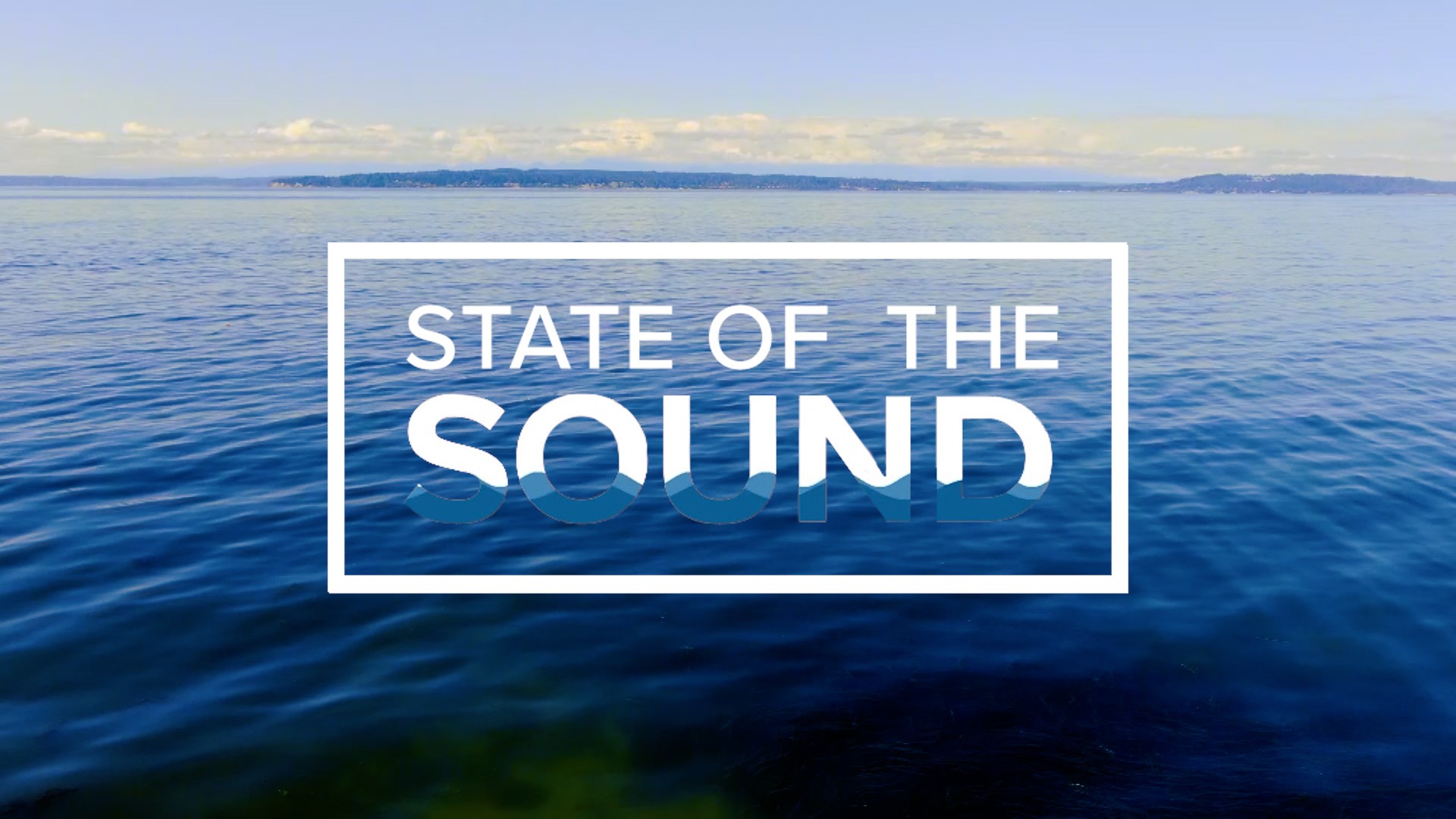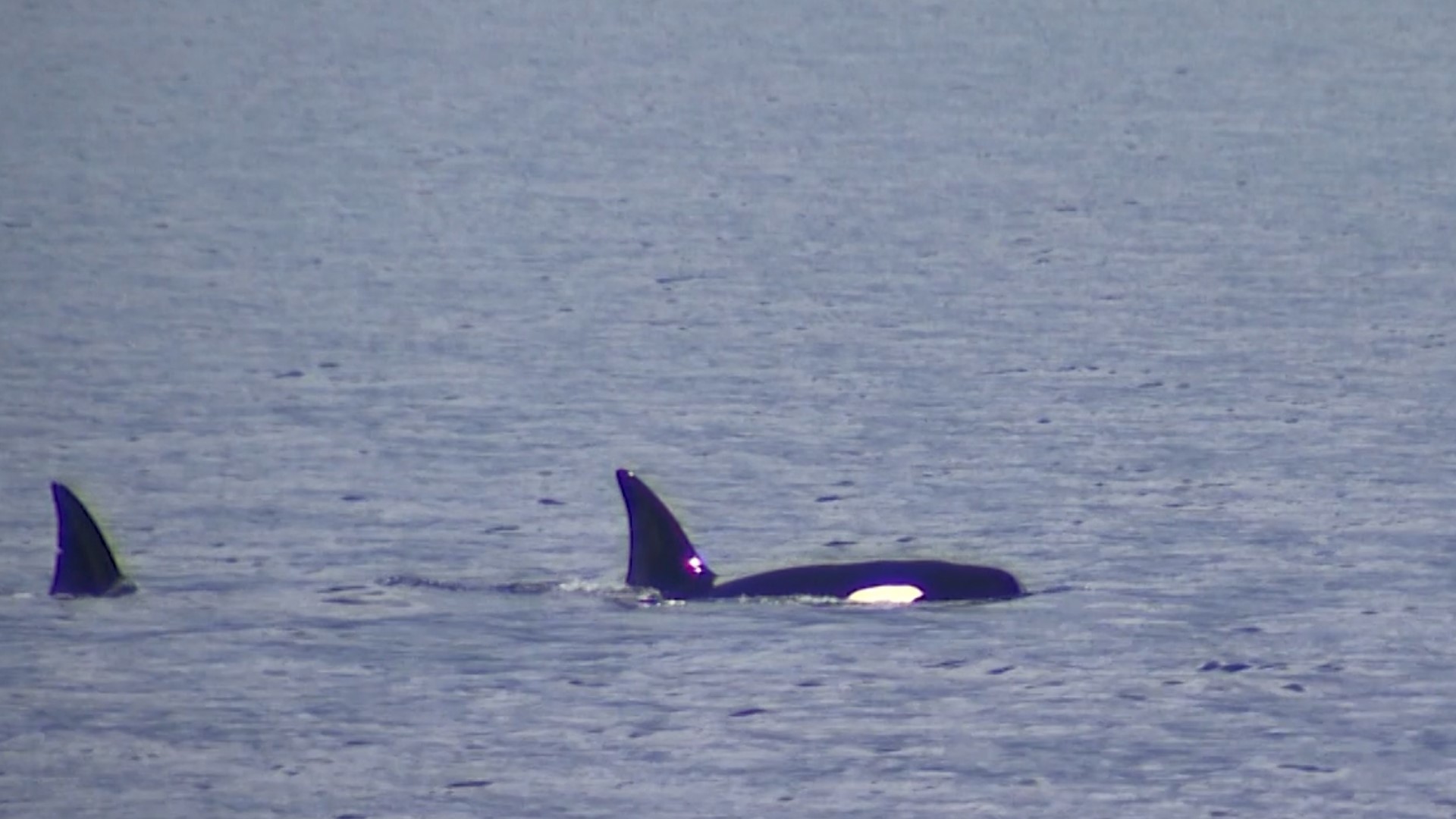State of the Sound: Efforts to protect Puget Sound’s ecosystem
From whale protections to monitoring kelp forests, environmentalists are working to protect the ecosystem of Puget Sound, the nation's second largest marine estuary.

The Pacific Northwest is full of beauty, but it is also a place where nature and humanity need to coexist so future generations can enjoy the place we call home.
From taking steps to protect whales to monitoring the health of kelp forests, environmentalists are working to protect the ecosystem of Puget Sound, the second-largest estuary in the United States.
In this series titled "State of the Sound," KING 5 took a look at what is being done on land and in the depths of Puget Sound to preserve the environment and animals we have come to know and love.
Whale sightings spike
Whales in Puget Sound. It’s a sight that draws crowds and silences onlookers. The distinct black and white patterns of orcas are part of the culture and history of the Pacific Northwest. But in recent years, encounters between boaters and whales are concerning those who know the species best.
“We love [whales] so much,” Puget Sound Express Captain Brian McGinn said from a dock in Edmonds. “Most of us on board now are so excited about it all the time. It doesn’t matter how many times you see it, it’s still amazing.”
Like many whale-watching companies in the Pacific Northwest, Puget Sound Express relies on reports from a network of spotters. From there, it’s a race to potential sightings, and the hunt for a glimpse of the massive mammals is on.
“If [the whales] go down for five minutes, you better be looking at the right place at the right time when they come back up again,” explained McGinn.
But not every boater on Washington’s waterways has the same admiration and care for the animals, as some recent close encounters are causing concern for environmentalists.
Earlier this spring, KING received a video from a viewer that showed someone driving a jet ski headed straight for the whale in the waters near Tacoma. Kata survived the encounter – and today serves as a reminder of a reality we’re facing.
Humpback whales and Bigg's killer whales, also known as transient orcas, were once hunted and both victims of pollution and climate change. But according to the Pacific Whale Watching Association, the tide is turning.
Humpback whales are benefiting from a record baby boom in recent years.
But despite new calves born in the past few years, the Southern Resident orca whale population in the state has been considered endangered since 2005. Southern Resident orcas spend much of their time in the waters between Washington state and British Columbia. And unlike transient orcas, which eat marine mammals, Southern Resident orcas feed exclusively on salmon.
Regardless, recent whale sightings are still up, but the open water in the Sound can quickly become crowded.
State and federal regulations require recreational boats to stay at least 300 yards to the sides of killer whales and 400 yards away in front and behind the animals. The Marine Mammal Protection Act calls for boaters to stay at least a football field away from humpback whales.
RELATED: 13 Southern Resident killer whales declared 'vulnerable,' boaters asked to keep their distance
But whale watching excursions bring a glimpse from above water into a world that most will never see: Animals in the wild, alive and free, in a quickly changing world.
'SoundGuardian'
A King County research vessel is helping scientists understand how a growing population and the threats of climate change could impact Puget Sound.
The vessel, known as "SoundGuardian," allows oceanographers to get a deep understanding of Puget Sound that’s not possible onshore.
“Puget Sound is a really dynamic place, and there are a lot of things happening all at once,” said Water Quality Planner/Project Manager Taylor Martin. “We can only know so much just by looking at the water. We have to actually go out on the water and collect samples to really get a handle on what is happening under the surface.”
King County has collected data about the health of Puget Sound’s Central Basin for decades to get a baseline of metrics like pH (ocean acidification), temperature, salinity, dissolved oxygen, algal blooms and nutrients such as phosphorus and nitrogen.
Having a baseline helps researchers identify and track changes as the population grows and the climate changes. SoundGuardian is their current research vessel, equipped with tools that allow them to do some on-board monitoring - though most analysis is done in laboratories.
Scientists collect samples every two weeks, stopping at stations that include locations near wastewater treatment plant outfalls, Elliott Bay and the Central Basin. Other stations include checkups on real-time continuous water quality monitors at the Seattle Aquarium and other buoys throughout King County’s marine environment.
Crunching data is complex, and it can be hard to pinpoint one factor most responsible for changes, which can be cyclical. But data has shown some trends, including a slight upward trend in temperature.
King County Department of Natural Resources and Parks Director Christie True said data can be analyzed to determine if changes are based on climate, season, or other factors such as the loss of trees in urban areas – or a combination of all these factors.
A large part of the monitoring work is also to assess how wastewater is impacting the Sound, if at all. In the mid-1950s, there was little wastewater treatment for the quickly-growing region. True said many lakes and rivers were polluted, and beaches had to be closed. That prompted the creation of a treatment system to capture wastewater and plan for the growth of the region.
As scientists continue to monitor Puget Sound, True said there are some things everyday people can do to contribute to its health. That includes picking up animal waste, reducing chemicals used in gardens and yards, and disposing of excess medication properly.
Kelp forest health
It is one thing to study the forests on land, but it's an entirely different thing to study the "forests" of the sea.
"When we think about forests, most of us are thinking about terrestrial forests, right? But these are underwater forests that are doing incredible work in terms of absorbing carbon dioxide, turning it into food that supports us," said Betsy Peabody, executive director of Puget Sound Restoration Fund (PSRF), a group dedicated to researching and preserving the marine life of its namesake.
With support from the Paul G. Allen Family Foundation, the PSRF launched a kelp monitoring initiative that takes a unique approach to their research. While much has been done on the surface level, Peabody said the "Eyes on Kelp" monitoring program goes beneath the surface to figure out why some kelp beds thrive while others decline.
“We're going to be doing underwater ecological monitoring with divers," Peabody said.
The project was launched as bull kelp populations in parts of Puget Sound have seen significant declines. For example, the south Sound has seen an 80% loss in bull kelp forests in the last 50 years, according to the fund. In the central Sound, where Seattle is located, there are places where kelp forests have disappeared entirely, like around Bainbridge Island.
The kelp monitoring program will expand to 14 stations throughout the Sound from the Strait of Juan de Fuca to Squaxin Island, near Olympia.
To obtain trained divers to help glean the data from kelp beds, the PSRF partnered with the Reef Check Foundation to train recreational divers to be underwater scientists.
The kelp monitoring program also includes a robotic monitoring component led by The Bay Foundation and Marauder Robotics.
Electrifying transportation
A city shaped by water is the inspiration for innovation. It’s why Washington state has become a leader in electric boating technology in the United States.
Seattle is a place where Pure Watercraft founder Andy Rebele sees opportunity. More than a decade ago, Rebele was reading about electric cars and thought it was useful technology for a boat.
“I didn't look around for how can I start a company. I looked around to just buy a boat," said Rebele. "But nobody was making an exciting electric boat."
What came next was the creation of Pure Watercraft, headquartered on the shore of Lake Union. The company created an outboard motor and built a completely electric pontoon boat.
The company launched in 2011 and announced a deal with General Motors last winter. The deal is a $150 million investment for a 25% stake in Pure Watercraft. Rebele said it is the largest investment a company has ever made in electric boating. The company is now building a facility in Tukwila to manufacture pontoon boats and outboard motors. The boats are powered by Pure Watercraft’s outboard motor and have a battery pack supplied by General Motors.
Washington State Department of Ecology records shows that since 2015, recreational vessels have spilled 14,662.5 gallons of fuel. But the department believes many spills are not reported, which means the number of gallons spilled is likely higher.
While oil spills are a problem eliminated with electric motors, electrification isn't for everything. Battery technology is heavy and relies on a predictable schedule to ensure there is time to re-charge the battery.
“A really good fit for electric is something that does a regular run of a fixed length,” said Rebele.
What Rebele described is something on a predictable and set schedule, such as the Washington State Ferries (WSF) system. WSF one of the largest consumers of fuel on Washington’s water and an ideal system for electrification.
Since 2017, Matt von Ruden, the WSF system electrification program administrator, and his team have been working to transform WSF, which uses 19 million gallons of diesel every year. Many of the changes will happen deep inside a vessel’s engine.
“What we want to do is replace two of the four diesel engines with big battery banks," explained von Ruden. "That way, we can initially drive them like a hybrid vehicle, where we can operate those diesel engines at their peak efficiency. Eventually, a couple years later, we're going to bring electricity from the shore and charge the batteries that way.”
WSF plans to use more than $1.3 billion in funding to launch two projects to help create a “greener” ferry fleet. The first project is to build new Olympic-class hybrid-electric vessels. The second project transforms four of the state's largest ships, which travel the route between Seattle, Bainbridge Island and Bremerton, into hybrid vessels. The funding also pays for the electrification of the Central Puget Sound Terminal, which will charge the vessels.
The plans for the ships are currently under approval and review by the U.S. Coast Guard.
WSF believes it is one of the first and largest U.S. ferry systems to transition to hybrid electricity. The innovation is pushing boating into the future, a future with less noise, cleaner water and air.


